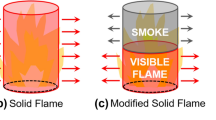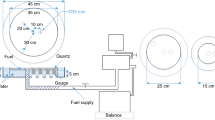Abstract
Thermal radiation is an important parameter to evaluate the hazard of pool fires. In the conventional solid flame model for the radiant heat flux calculation, the burning flame is often assumed to be of a cylinder or a cylinder–cone combined shape whose height and diameter equal the flame height and pool diameter, respectively. Obviously, the conventional model does not take into account the actual flame volume. Thus, this paper presents a revised solid flame model by correcting the flame diameter with the flame height and flame volume. The heat release rate per unit flame volume is approximately 1100 kW/m3 for hydrocarbon pool fires, by which the flame volume can be calculated with the known heat release rate. By theoretical analysis on experimental data in literature, correlations of centerline temperature and flame emissivity are proposed to calculate the flame surface emissive power of heptane pool fires. The obstruction effect of smoke around the burning flame on the thermal radiation is also considered by correcting the transmissivity of thermal radiation in the surrounding medium. Comparisons in prediction between the new and conventional models are conducted against the experimental measurements of 0.3 m, 0.5 m, 0.7 m, 1 m, 6 m heptane pool fires. It is found that the new model with the cylinder–cone combined shape assumption can better predict the thermal radiation from heptane pool fires in both near and far fields.












Similar content being viewed by others
Abbreviations
- \( c_{p} \) :
-
Specific heat of air at constant pressure (kJ/kg k)
- \( c_{s} \) :
-
Mass concentration of smoke in the flame gases (kg smoke/m3)
- C T, f :
-
A constant (Eq. 10)
- D :
-
Pool diameter (m)
- E :
-
Flame surface emissive power (kW/m2)
- E max :
-
Emissive power of clear burning flame, 140 kW/m2 (Eq. 6)
- E s :
-
Emissive power of flame surrounded by smoke, 20 kW/m2 (Eq. 6)
- F :
-
Geometrical view factor
- F 1-v :
-
View factor of part 1 to the target
- F 2-v :
-
View factor of part 2 to the target
- g :
-
Gravitational acceleration (m/s2)
- H :
-
Mean flame height (m)
- H c :
-
Continuous flame height (m)
- H i :
-
Intermittent flame height (m)
- \( {{\Delta h_{c} } \mathord{\left/ {\vphantom {{\Delta h_{c} } {S_{a} }}} \right. \kern-0pt} {S_{a} }} \) :
-
Energy produced by consuming unit mass of oxygen (Eq. 10)
- k :
-
\( {\text{Coefficient}} = \left( {{r \mathord{\left/ {\vphantom {r {\left( {H_{i} - H_{c} } \right)}}} \right. \kern-0pt} {\left( {H_{i} - H_{c} } \right)}}} \right)^{2} \)
- L :
-
Horizontal distance from the center of the pool fire to the target edge (m)
- l b :
-
Mean beam length (m)
- \( \dot{m}^{\prime\prime} \) :
-
Mass burning rate per area (kg/m2 s)
- \( \dot{m}^{\prime\prime}_{\infty } \) :
-
Mass burning rate per area of a pool fire with infinite diameter (kg/m2 s)
- \( \dot{q}^{\prime\prime} \) :
-
Radiant heat flux (kW/m2)
- \( \dot{q}^{\prime\prime}_{1 - v} \) :
-
Radiant heat fluxes received by the target from part 1 (kW/m2)
- \( \dot{q}^{\prime\prime}_{2 - v} \) :
-
Radiant heat fluxes received by the target from part 2 (kW/m2)
- \( \dot{Q} \) :
-
Heat release rate (kW)
- r :
-
Flame radius (m)
- R :
-
The distance from the point source to the target (m)
- s :
-
Extinction coefficient, 0.12 m−1 (Eq. 6)
- T :
-
Flame temperature (K)
- T a :
-
Ambient air temperature (K)
- T c :
-
Flame temperature in continuous flame zone (K)
- T i :
-
Flame temperature in intermittent flame zone (K)
- \( \Delta T \) :
-
Excess temperature (K)
- \( \Delta T_{McC} \) :
-
Excess temperature calculated by McCaffrey formula (K)
- z :
-
Height above the burner surface (m)
- \( \alpha ,\gamma \) :
-
Diameter correction coefficient
- \( \beta \) :
-
Mean-beam-length corrector
- \( \varepsilon \) :
-
Flame emissivity
- \( \kappa \) :
-
Absorption coefficient (m−1)
- \( \kappa_{m} \) :
-
Specific soot extinction area (m2/kg)
- \( \rho_{a} \) :
-
Ambient air density (kg/m3)
- \( \sigma \) :
-
Stefan-Boltzmann constant, \( 5.67 \times 10^{ - 8} \) W/(m2 K4)
- \( \tau \) :
-
Transmissivity
- \( \tau_{a} \) :
-
Transmissivity of atmosphere
- \( \tau_{s} \) :
-
Transmissivity of smoke
- \( \phi \) :
-
Correction coefficient (Eq. 14)
- \( \chi_{r} \) :
-
Radiation fraction
- 1,2:
-
Body 1, body2
- v :
-
Vertical object
References
Planas-Cuchi E, Montiel H and Casal J (2009) A survey of the origin, type and consequences of fire accidents in process plants and in the transportation of hazardous materials. Process Saf Environ 75:3–8
Abdolhamidzadeh B, Abbasi T, Rashtchian D, et al (2011) Domino effect in process-industry accidents–an inventory of past events and identification of some patterns. J Loss Prevent Proc 24:575–593
Modak AT (1977) Thermal radiation from pool fires. Combust Flame 29:177–192
Orloff L, De Ris J (1982) Froude modeling of pool fires. Proc Combust Inst 19:885–895
Raj PK (2007) LNG fires: a review of experimental results, models and hazard prediction challenges. J Hazard Mater 140: 444–464
Heskestad G (1983) Luminous heights of turbulent diffusion flames. Fire Saf J 5:103–108
Shokri M, Beyler C L (1989) Radiation from large pool fires. J Fire Prot Eng 1:141–149
Beyler, C L (2016) Fire hazard calculations for large, open hydrocarbon fires. SFPE handbook of fire protection engineering. Springer, New York, pp 2591–2663
Thomas PH (1963) The size of flames from natural fires. Proc Combust Inst 9:844–859
Zhou K, Liu N, Zhang L et al (2014) Thermal radiation from fire whirls: revised solid flame model. Fire Tech 50:1573–1587
Zhou K, Jiang J and Zhang X (2016) Flame pulsation-based model for predicting radiant heat flux of pool fire. J Nanjing Tech Univ (Nat Sci Ed) 38:114-118.
Wan H, Gao Z, Ji J et al (2018) Predicting heat fluxes received by horizontal targets from two buoyant turbulent diffusion flames of propane burning in still air. Combust Flame 190:260–269
Wang P, Liu N, Bai Y et al (2017) An experimental study on thermal radiation of fire whirl. Int J Wildland Fire 26:693–705
Raj PK (2007) Large hydrocarbon fuel pool fires: physical characteristics and thermal emission variations with height. J Hazard Mater 140:280–292
Hankinson G and Lowesmith B J (2012) A consideration of methods of determining the radiative characteristics of jet fires. Combust Flame 159:1165–1177
McCaffrey BJ (1979) Purely buoyant diffusion flames-some experimental results. Natl Inst Stand Technol. https://doi.org/10.6028/nbs.ir.79-1910
Luketa A and Blanchat T (2015) The phoenix series large-scale methane gas burner experiments and liquid methane pool fires experiments on water. Combust Flame 162:4497–4513
Sjöström J, Amon F, Appel G et al (2015) Thermal exposure from large scale ethanol fuel pool fires. Fire Saf J 78:229–237
Hiroshi K, Taro Y (1988) Air entrainment and thermal radiation from heptane pool fires. Fire Tech 24:33–47
Ma TG, Quintiere JG (2003) Numerical simulation of axi-symmetric fire plumes: accuracy and limitations. Fire Saf J 38:467–492
Hamins A, Klassen M, Gore J et al (1991) Estimate of flame radiance via a single location measurement in liquid pool fires. Combust Flame 86: 223–228
Raj VC, Prabhu SV (2018) Measurement of geometric and radiative properties of heptane pool fires. Fire Saf J 96:13–26
Raj VC, Prabhu SV (2017) A refined methodology to determine the spatial and temporal variation in the emissivity of diffusion flames. Int J Therm Sci 115:89–103
Fang J, Wang J, Tu R et al (2018) Optical thickness of emissivity for pool fire radiation. Int J Therm Sci 124:338–343
Babrauskas V (1983) Estimating large pool fire burning rates. Fire Tech 19:251–261
Gore JP, Klassen M (1994) Structure and radiation properties of pool fires. Report NIST-GCR-94-651
Hu L, Kuang C, Zhong X et al (2017) An experimental study on burning rate and flame tilt of optical-thin heptane pool fires in cross flows. Proc Combust Inst 36:3089–3096
Chen B, Lu S, Li C et al (2012) Unsteady burning of thin-layer pool fires. J Fire Sci 30:3–15
Gore J, Klassen M, Hamins A et al (1991) Fuel property effects on burning rate and radiative transfer from liquid pool flames. Fire Saf Sci 3:395–404
Buch R, Hamins A, Konishi K et al (1997) Radiative emission fraction of pool fires burning silicone fluids. Combust Flame 108:118–126
Hayasaka H (2011) Unsteady burning rates of small pool fires. Fire Saf Science 45:19–25
Wayne F D (1991) An economical formula for calculating atmospheric infrared transmissivities. J Loss Prev Proc 4:86–92
Notarianni K A, Evans D D, Walton W D, et al (1993) Smoke production from large oil pool fires. Proceedings of INTERFLAM 93:111-119.
Cox G (1995) Combustion fundamentals of fire. Academic Press, London
Stratton BJ (2005) Determining flame height and flame pulsation frequency and estimating heat release rate from 3D flame reconstruction. University of Canterbury, Christchurch
De Ris JL, Orloff L (2005) Flame heat transfer between parallel panels. Fire Saf Sci 8: 999–1010
Khan MM, Jamison K, De Ris JL (2011) Upward fire growth over thermally thin corrugated paperboard. Fire Saf Sci 10:513–526
Xin Y (2014) Estimation of chemical heat release rate in rack storage fires based on flame volume. Fire Saf J 63:29–36
Zukoski EE, Cetegen BM and Kubota T (1985) Visible structure of buoyant diffusion flames. Proc Combust Inst 20:361–366
Acknowledgements
This work was sponsored by the National Key Research and Development Plan (No. 2016YFC0800100), the National Natural Science Foundation of China under Grant Nos. 51876088 and 51506082, and Jiangsu Province Graduate Student Training Innovation Project (No. KYCX17_0918).
Author information
Authors and Affiliations
Corresponding authors
Additional information
Publisher's Note
Springer Nature remains neutral with regard to jurisdictional claims in published maps and institutional affiliations.
Rights and permissions
About this article
Cite this article
Shen, G., Zhou, K., Wu, F. et al. A Model Considering the Flame Volume for Prediction of Thermal Radiation from Pool Fire. Fire Technol 55, 129–148 (2019). https://doi.org/10.1007/s10694-018-0779-y
Received:
Accepted:
Published:
Issue Date:
DOI: https://doi.org/10.1007/s10694-018-0779-y




